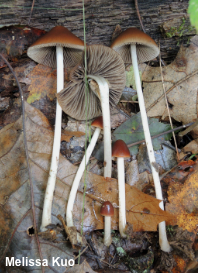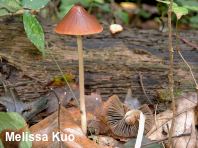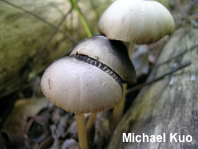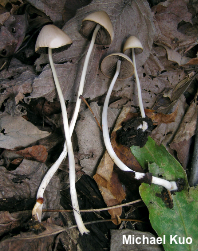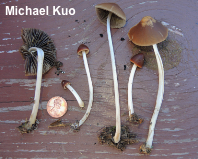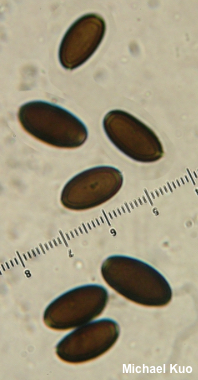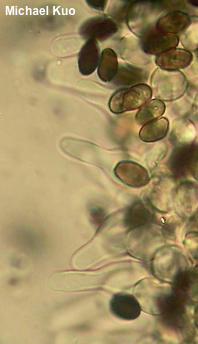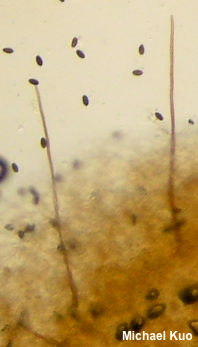| Major Groups > Gilled Mushrooms > Dark-Spored > Psathyrella > Parasola conopilea |

|
Parasola conopilea [ Basidiomycota > Agaricales > Psathyrellaceae > Parasola . . . ] by Michael Kuo With impressive, long setae on the cap surface, abundant cheilocystidia, and large spores, this mushroom is pretty distinctive under the microscope—but not to the naked eye. Despite its current genus name, it looks like a whole slew of boring, brown Psathyrella species, and until very recently it was known as Psathyrella conopilea. Like species in Psathyrella (as traditionally defined), Parasola conopilea features a fragile stem, a dark spore print, and a hygrophanous brown cap. But several recent studies have supported placing this species in the coprinoid genus Parasola; see the discussion below if you care. Parasola conopilea grows gregariously, but usually not in clusters; this fact will help separate it from the western North American species Psathyrella atrospora, which is very similar, but smaller and usually found in dense clusters—and from Psathyrella circellatipes, which is also similar but grows in dense clusters and features orangish hairs on the cap and stem base when young. Three papers published in a two-year period (Padamsee and collaborators, 2008; Larsson & Örstadius, 2008; Nagy and collaborators, 2009) presented DNA results that included Parasola conopilea. In all three studies specimens labeled Psathyrella conopilea grouped with the genus Parasola—usually in a basal position (suggesting that the species in Parasola may have evolved from a species like Parasola conopilea). Also in all three studies, the genus Psathyrella as traditionally defined was incoherent, dividing itself all over the map with Coprinopsis, Coprinellus, and Lacrymaria. Despite similar results for Psathyrella conopilea, the papers present different proposals for the taxon. Padamsee and collaborators suggest that "P. conopilea could represent a unique genus" (427), since, despite the fact that it groups with Parasola, it has pileocystidia when none of the other known species of Parasola demonstrate this morphological feature. Larsson and Örstadius simply transfer Psathyrella conopilea to Parasola as an official new combination. Nagy and collaborators agree, because "inclusion in Parasola is better justified so as to keep the number of new genera as low as possible" (35). "Parasola conopilus" is an error in Latin agreement. Description: Ecology: Saprobic; growing scattered to gregariously or in loose clusters of 2–4 mushrooms (but not densely clustered) from the deadwood or litter of hardwoods, or from dung; found in hardwood forests or in cultivated areas; spring and fall; widely distributed in North America; also found in Europe and Australasia. The illustrated and described collections are from Illinois and Michigan. Cap: 2–5 cm; conic, becoming broadly conic, broadly bell-shaped, or more or less convex; bald or, with a hand lens, with tiny projecting hairs; sometimes becoming radially wrinkled; reddish brown, fading to pale tan; changing color markedly as it dries out; without veil remnants; the margin not lined. Gills: Narrowly attached to the stem; close or nearly distant; pale brownish at first, becoming dark gray to nearly black; short-gills frequent; with whitish edges. Stem: 5–13 cm long; 2–4 mm thick; equal; fragile; becoming hollow; bald; white; without a ring; basal mycelium white. Flesh: Thin; fragile; pale, watery brownish. Odor and Taste: Not distinctive. Spore Print: Black. Microscopic Features: Spores 14–18 x 6–8 µm; ellipsoid, with a pale pore; smooth; dark brown in KOH; dark brown in Melzer's. Basidia 4-sterigmate; abruptly clavate. Brachybasidioles present. Cheilocystidia abundant; 35–50 x 12.5–17.5 µm; lageniform, often with a fairly long neck, or subcylindric, subutriform, or sphaeropedunculate; smooth; thin-walled; hyaline in KOH. Pleurocystidia not found. Pileipellis hymeniform-cellular; elements 15–25 µm across, irregularly subglobose, smooth, hyaline in KOH; setae 200–250 x 2.5–5 µm, aciculate, thick-walled, reddish brown in KOH. REFERENCES: (Fries, 1821) Örstadius & E. Larsson, 2008. (Smith, 1972; Kits van Waveren, 1977; Smith, Smith & Weber, 1979; Moser, 1983; Hansen & Knudsen, 1992; Breitenbach & Kränzlin, 1995; Barron, 1999; Larsson & Örstadius, 2008; Padamsee et al., 2008; Nagy et al., 2009; Kuo & Methven, 2014; Szarkándi et al., 2017; Læssøe & Petersen, 2019.) Herb. Kuo 10070301, 10290704, 09281902. This site contains no information about the edibility or toxicity of mushrooms. |
© MushroomExpert.Com |
|
Cite this page as: Kuo, M. (2020, January). Parasola conopilea. Retrieved from the MushroomExpert.Com Web site: http://www.mushroomexpert.com/parasola_conopilea.html |
